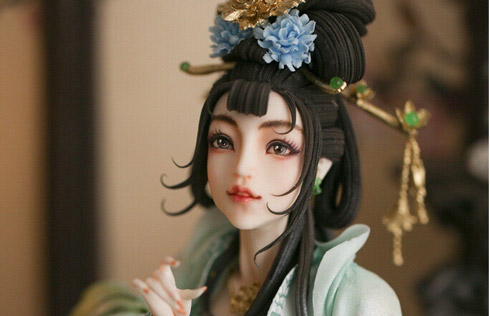Festive lanterns
(Xianju Festive Lanterns, Xiashi Colored Lanterns, Quanzhou Festive Lanterns, Dongguan Thousand-Corner Lanterns, Huangyuan Row Lanterns)
Year: 2006
Sort: Folk Fine Arts
Area: Zhejiang, Fujian, Guangdong and Qinghai provinces
Serial No.: Ⅶ-50
Ⅰ. Xianju Festive Lanterns
Declarer: Xianju County, Zhejiang Province
Xianju boneless festive lanterns originated in the Tang Dynasty (618-907) in Xianju County in East China's Zhejiang Province. The embroidered boneless festive lantern of Xianju is reputed as the "No. 1 lantern of China", and Xianju is thus honored as the "home of festive lanterns."The frameless lanterns from the town of Xianju are especially light -- in both senses of the word -- because they don't have frames. To take on particular shapes, they rely instead on multiple layers of paper stuck together. Fine needle holes pricked into the paper let out rays of light from within.
This detailed process calls for five days on a single piece, and even longer for those of greater complexity. It once boasted more than 80 varieties during its peak, but so far only 27 kinds have been revived after years of salvage efforts.
In ancient times, Xianju lanterns were reserved for use in imperial palaces and their construction techniques limited to only a few artisans.
Ⅱ. Xiashi Colored Lanterns
Declarer:Haining City, Zhejiang Province
The making of Xiaoshi colored lanterns is an ancient folk art in Haining, East China's Zhejiang Province. It can be traced back 1,200 years and was popular early in the Tang Dynasty (618-907). Later in the Southern Song Dynasty (1127-1279), Xiashi colored lanterns were used as tribute articles for the court.
During the Qing Dynasty (1644-1911), people took the various lanterns in hand or carried them on the shoulder and went to the streets, singing and dancing to the deafening sound of gongs and drums. The long contingents were usually as long as several kilometers. Such grand lantern festivals gradually became an important folk custom in Haining.
The making of Xiaosi colored lanterns is very meticulous and uses eight skills and stitchwork patterns. They are mainly made of rice paper, sawali, and lead wire, and incorporate the eight traditional skills of "drawing, bending, carving, fastening, embroidering, mounting, pasting and tying" into an organic whole.
There is a variety of Xiashi colored lanterns with various themes, and they can be divided into five varieties; desk lanterns, portable lanterns, wall lanterns, hanging lanterns and gift lanterns. The mountains, water, flowers, birds, beats, towers, pavilions and various characters from folk tales used as decorations reflect the light and make the pictures vivid. The lifelike, florid and exquisitely carved pictures are typical of Xiashi colored lantern making, which has won prizes both at home and abroad.Xiashi colored lanterns are the crystallization of collective wisdom that has passed from generation to generation and possesses high technological and aesthetic value.
Ⅲ. Quanzhou Festive Lanterns
Declarer: Quanzhou City, Fujian Province
Quanzhou is a southeast coastal city in Fujian Province, East China. Quanzhou festival lanterns originated in the Tang Dynasty and prospered during the Song and Yuan periods (960-1368). With an ancient history and distinctive local flavor, Quanzhou festival lanterns are considered the representative of lanterns in South China.
Quanzhou has been dubbed the 'lantern city' ever since a poem was written that said "the moonlight shines/on the ancient pagoda for 1,000 years/and the rainbow hangs lanterns/stretching for ten miles on Chang'an Street."
It is most famous for its unique cardboard, embroidery and mounting techniques. The lanterns vary in terms of frame materials. The frames could be built from wood, iron lines and bamboo strips. Additionally, the way of folding the paper into squares could also be used to build the frame, and the frames were covered with paper or silk material and decorated with poems, calligraphy or paintings. Needles were also used for poking holes in the paper to make outlines of men or animal figures.
Carved cardboard lanterns were first created by Master Li Yaobao (1892-1983).All the patterns are designed and carved out of cardboard. No frame is needed to make a lantern. All the carved cardboard, when patched up, form an exquisite lantern that leaks light from the middle, giving off a mystical luster. Despite carved cardboard lanterns, Quanzhou also has frameless festival lanterns.
Ⅳ. Dongguan Thousand-Corner LanternsDeclarer: Dongguan, Guangdong Province
The Thousand-Corner Lanterns are the gem of folk art in Dongguan, Guangdong Province. The Zhao family, royal descendants of the Song Dynasty (960-1279AD) originally began making the lanterns early in the Yuan Dynasty (1271-1368). Each lantern had 24 decorative colored ribbons. It was said that the Thousand Corner Lanterns were made once every ten years, and the ribbons were kept unchanged and treasured by the Zhao family for centuries. Unfortunately the ribbons were ruined in the 1960s.
Ⅴ. Huangyuan Row Lanterns
Declarer: Huangyuan County, Qinghai Province
Huangyuan Row Lanterns are popular in Chengguan Town, Huangyuan County. Their origins can be traced back to the large and well-lit shop signposts in the early 18th century in the Qing Dynasty (1644-1911). The signposts along the streets of Huangyuan were colorful and exquisitely made, with various beautiful designs. The row lanterns were based on these signposts.
The row lantern, as the name suggests, is a large, long lantern with a finely engraved frame made of top-grade wood, shaped in rectangles, saddles or fans. It is usually two meters long, 0.6 meters high, and 0.4 meters thick, divided into three to six partitions, each with a particular design. The themes of the designs range from historical figures, literary quotations, landscapes and flowers to birds. When the candle in the lantern is lit, the rows of row lanterns make a grand sea of light.


















